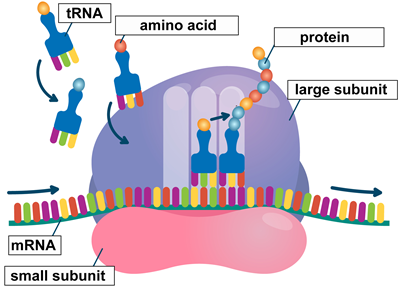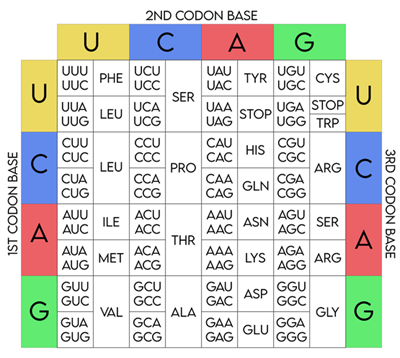RNA and Protein Synthesis
RNA - ribonucleic acid
- has ribose
- singled strand
- uracil (instead of thymine)
Types of RNA
Messenger RNA (mRNA) - carries DNA instructions to the ribosomes
Ribosomal RNA (rRNA) - subunits of ribosomes
Transfer RNA (tRNA) - carries amino acids to the ribosomes
Central Dogma - DNA codes for RNA, which codes for protein
Transcription (DNA --> RNA)
Base pair rule ( Guanine to Cytosine; Adenine to Uracil)
One side of the DNA is the template
RNA polymerase builds a strand of RNA based on the template code
Example:
DNA: A T A C A G
RNA: U A U G U CPromoter - region where RNA polymerase binds to mRNA and begins transcription
RNA Editing
Introns - pieces of RNA that are removed
Exons - remaining pieces are spliced together (and sent to ribosomes)
14.2 Ribosomes and Protein Synthesis
Polypeptides - chains of amino acids that form proteins
Genetic code
- three bases on mRNA, the codon
- codons determine a single amino acid
- RNA to protein is called TRANSLATION
How does RNA make a protein?
RNA tells the ribosomes what protein to build
Every three letters (AAA) specifies a single amino acid
Proteins are made of many amino acids, folding into a 3D shapeA codon chart is used to determine the amino acid
Start codon (MET) initiates translation
Stop codon - ends translation
Assignment: Protein Synthesis and Codons Practice
Translation
1. Begins at the start codon
2. Transfer RNA attaches to mRNA
3. Rivosome joins amino acids together
4. Chain grows until the stop codon

14.4 Mutations
- changes in the sequence of nucleotides
- changes in chromomes
Mutagens - agents in the environment that can cause mutations
Types of DNA Mutations
Substitution - change in a single base; which changes the amino acid
Silent mutations occur when the change in base does not change the amino acid
Insertion and Deletions - when a single base is added or lost; results in a frameshift
Chromosome mutations
Deletion - section is lost
Duplication - section is repeated
Inversion - section is flipped
Transloation - section moves to another chromosome
How Can a Single Mutation Cause Disease?
Hemoglobin is a protein that makes up blood cells

When a protein is made wrong (by the DNA code), it may become nonfunctional
Hemophilia - blood clotting proteins don't work
Sickle Cell Disease - blood cells are shaped wrong
Cystic Fibrosis - cell membrane doesn't move chloride ions
